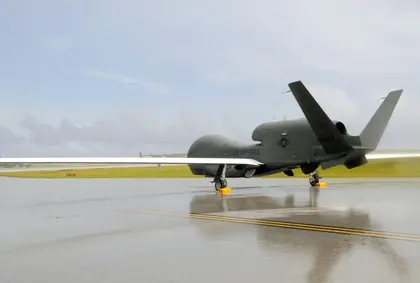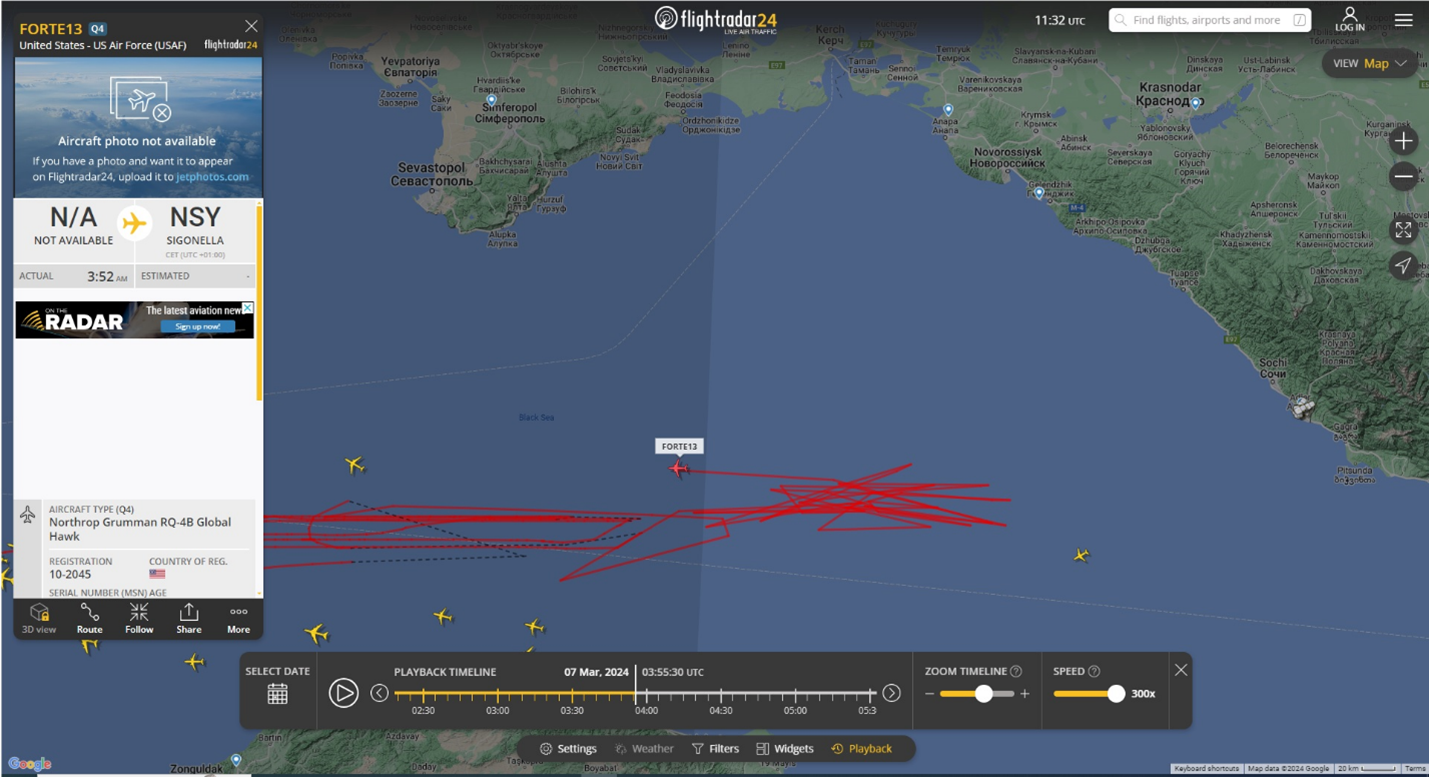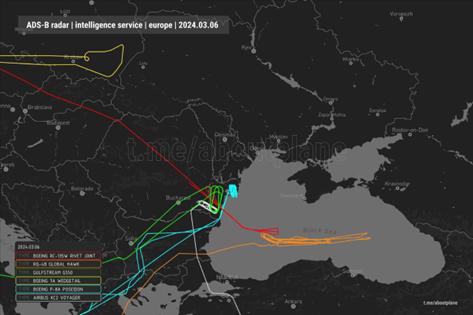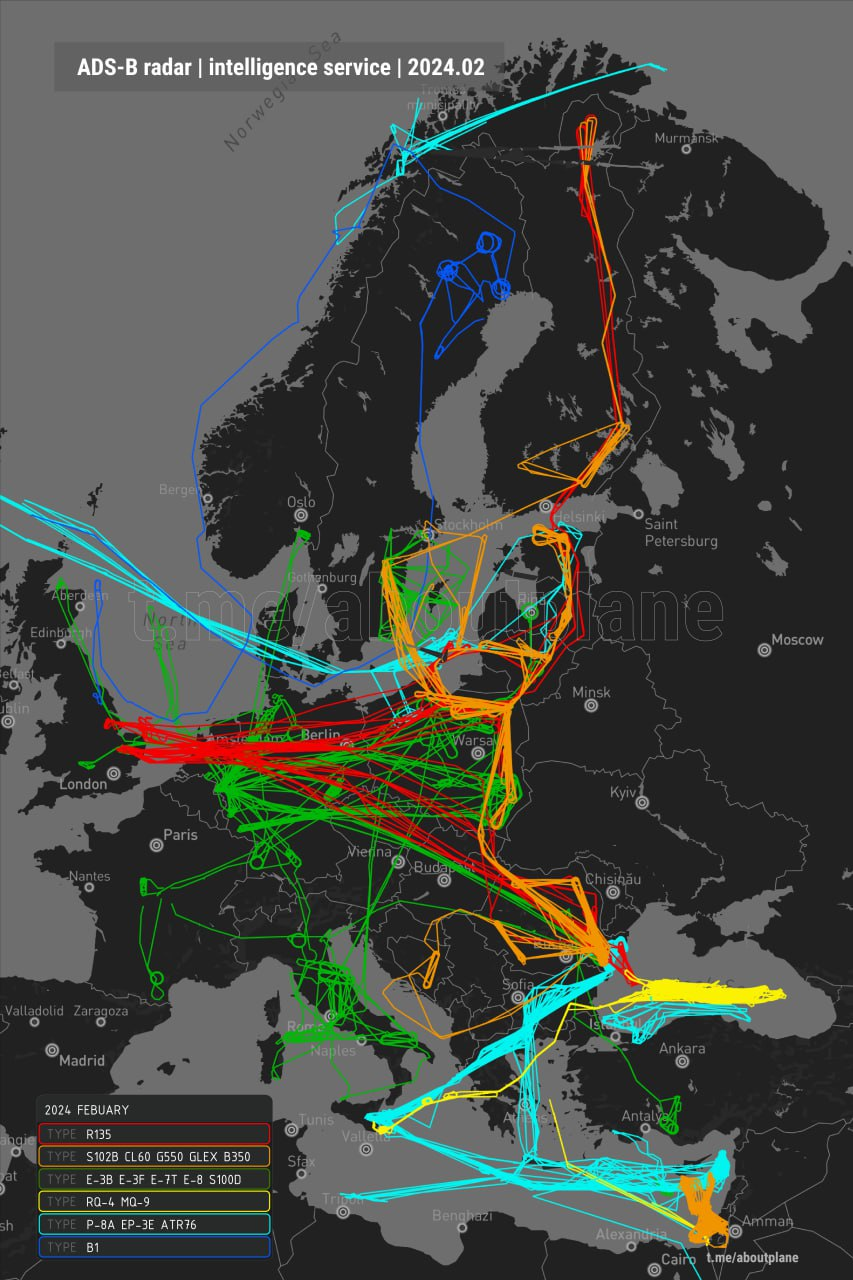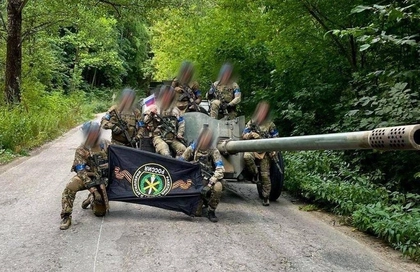The skies over the Black Sea and east Romania were buzzing with NATO aircraft on Wednesday with at least a half dozen spy planes and maybe a pair of fighter jets in the air at one time, and one of them – a US Global Hawk robot plane – pushing hundreds of kilometers eastwards to a close proximity with the Russian mainland.
The spike in activity was first recorded by the civilian air traffic watch platform flightradar24. Military aircraft monitoring enthusiasts widely confirmed the data and matched findings by Kyiv Post researchers checking posted flight routes.
JOIN US ON TELEGRAM
Follow our coverage of the war on the @Kyivpost_official.
According to the open-source flight information, at least six dedicated reconnaissance aircraft owned by NATO air forces were operating in air space over eastern Romania or the western Black Sea on Wednesday. In one important case, those surveillance operations continued well into the dark hours of Thursday and were flown well within missile range of Russia’s southwest coast.
The flights took place one day after Ukraine’s military used robot boats carrying explosives to sink the Russian heavy patrol ship Sergei Kotov some 500 km to the east.
The Atlantic Alliance in past months has routinely operated air surveillance flights over Romania’s Danube delta region, or seas just to the east, almost every day. Usually, the airborne overwatch is a pair of aircraft, typically a Boeing P-8 Poseidon naval surveillance aircraft and another plane designed to locate radar signals and intercept radio transmissions, often a modified Gulfstream corporate jet.

Finland PM Says Russia ‘Permanent’ Threat to EU
On Wednesday, according to radar track data, besides those routine aerial sniffer planes, NATO air planners deployed an advanced Boeing RC-135W Rivet Joint, a flying eavesdrop aircraft with onboard computers and sensors capable of scooping up millions of electronic transmissions a minute and sorting through them digitally. The last time open-source observers had spotted a Rivet Joint in the air over east Romania was Feb. 26.
At a safe distance from the airborne radio and electronics interceptors above east Romania, according to indicated tracks staying over east Poland on Wednesday, flew an even rarer, and more expensive, AWACS plane called a Boeing E-7A Wedgetail.
Carrying a cigar-shaped radome on its back, the Wedgetail is a flying command post and early-warning platform with the primary mission of assisting NATO fighter jets locate and intercept targets. The Wedgetail’s observation range is classified but, by NATO air doctrine, above east Poland the plane was well-placed to monitor air space over the western Black Sea and, if necessary, to vector combat aircraft into battle.
But the most eyebrow-raising of NATO’s air activity on Wednesday, and by some measures of the entire Russo-Ukraine war, probably was the travels of a US Global Hawk spy plane, that penetrated previously little-monitored air space hundreds of kilometers of where NATO monitoring aircraft had dared fly in the past.
In a mission lasting well over 24 hours, a US Air Force Global Hawk based at Naval Air Station Signonella, Sicily on March 6 took up an observation station some 140 km due south of the Russia-occupied Crimea at about 10 a.m. local time and cruised lazily back and forth at speeds between 250-320 knots for the next eight hours.
Capable of flying up to 30 hours at extremely high altitudes, the $135 million Global Hawk is rated the most capable reconnaissance drone operated by any air force and one of the US military’s top air intelligence collection assets.
According to open sources, the Northrop Grumman unmanned plane can be configured to intercept radio communications, identify and triangulate radars and radio emitters, and create hi-resolution images of the ground, sea, and objects on it over swaths of hundreds of square kilometers.
At about 5 p.m. local time, as the sun set, Forte13 turned east and spent the next ten hours flying reconnaissance patterns due south of the Kotov’s sinking site, and close to 100 km from the Russian mainland and the resort city Sochi. The robot jet flew finger-like standard reconnaissance patterns for the next ten hours.
The nearest Kremlin-owned military facilities and infrastructure included some of the most sensitive military infrastructure in all of Russia, particularly the Kerch Bridge, the Russian Black Sea Fleet’s temporary main base Novorossisk, and irreplaceable drydocks and air defenses nearby.
Although the flight route flown by the US spy plane remained well outside Russian national airspace at all times, it was one of the closest confirmed passes, by any US military aircraft, to Russia’s Black Sea shores, since Russia's full-scale of Ukraine in February 2022. Not all US military flight routes are made public.
A Russian Su-27 fighter jet collided with a US Air Force Reaper drone flying over the Black Sea on March 14, 2023, knocking the American aircraft out of the sky. According to subsequent Pentagon statements, the incident took place over international waters near the island of Zmiiknyi. Russian military information platforms reported the US spy plane was flying without a transponder and that a pair of Russian fighter pilots attempted to divert it by dumping fuel in the Reaper’s path. The engagement ended when one Russian combat plane accidentally struck the US drone’s propeller.
The closest NATO and Russia appear to have come to an actual shooting incident took place in September 2022 when a pair of Russian Su-27 fighters intercepted a single British RC-135 Rivet Joint reconnaissance plane, and one of the Russian fighter pilots attempted to fire a missile at the British military aircraft, following a misunderstanding of orders from Russian ground control.
British Defence Minister briefed parliament the next month that loss of life and a potential act of war by Russia against a NATO member was avoided because the Russian missile failed to launch. The incident took place off the Crimea coast.
Some monitoring sites reported that on Wednesday, during the jump in NATO air surveillance around the western Black Sea, and the US Global Hawk’s provocative sortie towards southwest Russia, two Royal Air Force-operated Eurofighter Typhoons based at Mihail Kogălniceanu International Airport near Constanza Romania likewise also were in the air, or prepped to launch, as a reaction force in case of Russian interference. Kyiv Post could not confirm those reports.
Aside from reconnaissance aircraft, and combat aircraft possibly providing overwatch to those flights, the skies over eastern Romania on Wednesday were buzzing with other military aircraft and air activity.
Most prominent were multiple flights by Romanian Air Force cargo planes, one traveling to Germany, and almost continuous movement by US Army UH-60 Blackhawk helicopters around the Danube delta region and to the seas immediately eastward. Kyiv Post researchers counted at maximum four general purpose and one medevac Blackhawks in the air at one time.
You can also highlight the text and press Ctrl + Enter


